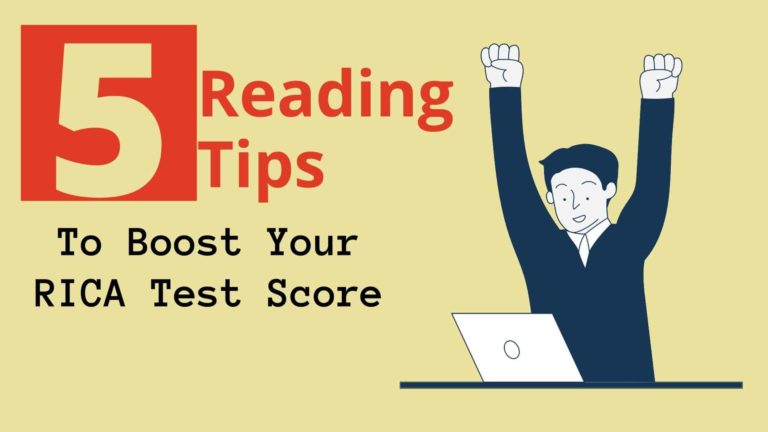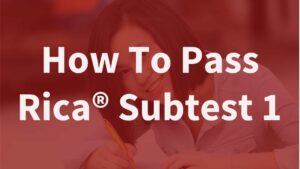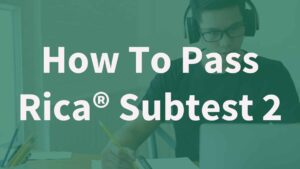RICA Test Written Examination
Candidates have the option to fulfill their Rica Test requirement by completing one of the following formats:
- Written Examination
- Video Assessment
This page discusses the overview about the written examination.
Purpose of the RICA Test
The RICA Test is an assessment given to people who want to become credentialed elementary teachers in California. The RICA Test checks teacher candidates’ understanding of and ability to provide effective reading instruction to young learners in the classroom.
3 Subtest Structure
The Rica Test is one examination that is split into 3 separate subtests.
Candidates are able to take the subtests in any order that they choose; however, it is important to know that each subtest’s content specifications build onto each other. This means that no matter which subtest you are taking next, you will find it beneficial to have a firm grasp for all three subtest’s content in order to pass each individual subtest.

13 Fundamental Reading Instruction Topics
Subtest 1:
- Phonological awareness and phonemic awareness
- Concepts about print
- Letter recognition
- Alphabetic principle
- Phonics
- Sight words
- Syllabic and structural analysis
- Spelling (orthography)
- Fluency
Subtest 2:
- Vocabulary, including academic/non-academic language, and background knowledge
- Comprehension- literary texts
- Comprehension- expository texts
Subtest 3:
- General reading strategies and assessments
Length of Tests
- Subtests I and II: 1 hour and 15 minutes per subtest
- Subtest III: 1 hour and 30 minutes
Scoring Weight of Tests
- Subtest 1:
- Multiple Choice: 85%
- Essay 1: 5%
- Essay 2: 10%
- Subtest 2:
- Multiple Choice: 85%
- Essay 1: 5%
- Essay 2: 10%
- Subtest 3:
- Multiple Choice: 80%
- Case Study: 20%
Rica Test Structure
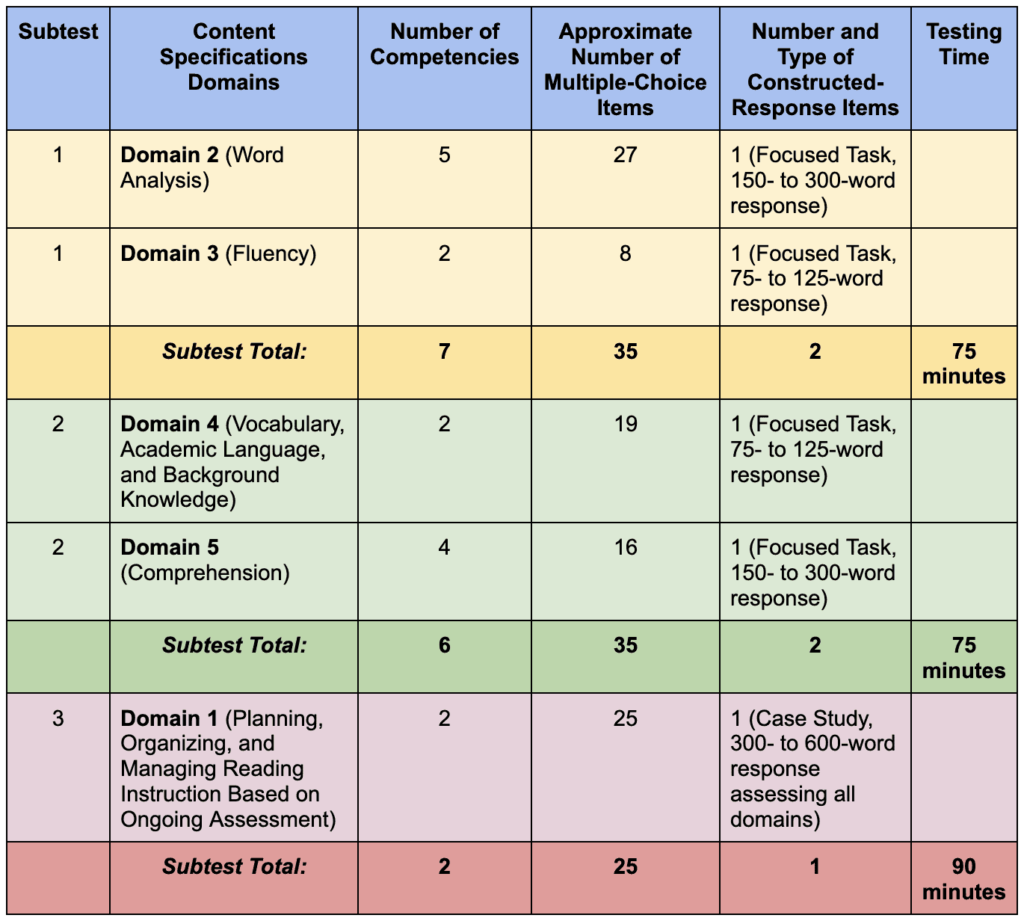
How Subtests are Administered
Candidates who register to take more than one subtest in a single session at a physical test center are presented one subtest at a time.
Each subtest is individually timed and administered in consecutive order beginning with Subtest 1.
After you complete a subtest, you will not be able to return to a subtest.
- 15 additional minutes are provided to complete a nondisclosure agreement and tutorial.
Multiple-choice questions: All three subtests include a total of 95 multiple-choice questions. The multiple-choice questions are designed with four possible answers, but only one is the best choice.
It is important to read all of the available options and to select the best option, as there is no penalty for guessing.
Some multiple-choice questions include graphs, tables, charts, journal entries and other illustrations or diagrams, and you will want to quickly, but carefully review all the information to select the best possible answer.
Constructed-response questions: The typical format of the constructed-response, or essay questions includes the given information pertaining to and about a student’s reading ability using a real-life situation, along with supplementary information in the form of charts and/or diagrams.
The test taker is then asked to discuss, describe, analyze, explain, or evaluate the given information and present a logical response, based on best practices for reading instruction.
Scoring: Reaching a score of 220 is considered a pass for each RICA subtest.
- Multiple-choice questions are scored electronically and tallied based on the number of questions answered correctly.
Constructed-response questions are evaluated by a trained person who judges the overall effectiveness of the response, according to the characteristics of reading instruction practices, teacher modeling, and student practice.

Test-Taking Strategies
The RICA subtests allow the test takers to complete the test in the order (multiple-choice or essay questions) that best suits the examinee. For this reason, it is important to develop a test-taking strategy that works best for you.
On the one hand, you can work on the multiple-choice section and use a notepad to jot down reading instructional strategies and key terms as you move through the exam. Then, when it’s time to write the constructed-responses, you will have an outline of content to refer to and use.
Take a moment and evaluate your own reading and writing speed and confidence for each skill. If you are a slower reader and a faster writer, it is wise to take the multiple choice section first, so that you make sure to complete the entire multiple choice section. If you feel confident in your understanding of the RICA specifications, key terms and reading strategies, it will be best to spend the first amount of time to thoroughly complete the constructed-response section.
Learn how to read faster for test day:
Learn how to read faster for test day:
Budget Your Time Well
The time you’re given to complete each subtest goes by fast. It’s important that you stay focused, read quickly, and answer questions as fast as you can while maintaining a high level of accuracy.
Here is the suggested time frame that will help you budget your time well:
Subtest 1
- Multiple choice section: 35 minutes
- Short essay: 15 minutes
- Long essay: 25 minutes
Subtest 2
- Multiple choice section: 35 minutes
- Short essay: 15 minutes
- Long essay: 25 minutes
Subtest 3
- Multiple choice section: 30 minutes
- Case Study: 60 minutes
Completing the Multiple Choice Section
Prepare for difficult multiple-choice questions on the RICA Test. Read quickly, yet thoroughly; mark your best answer and move forward.
It’s important that you remain calm and focused. Don’t let frustration set in, and certainly don’t make the mistake of spending too much time on a particular question.
Next, answer every question on the test. There is no penalty for answering a question incorrectly, so it is better to guess on a question than leave it blank.
Use the process of elimination. Remove answers that feel incorrect. Examine each word in the choices that remain, and select the best possible answer.
Writing Passing Essay Responses
There are a total of four essay questions, not including the Case Study. Within those four essay questions, two are shorter in length, and two are longer in length.
For the essay questions presented in Subtests 1 and 2, use this framework:
- Identify one need demonstrated by the student described in the question.
- Describe an instructional strategy to address this student’s need.
- Explain why the strategy you chose would effectively address this student’s need.
Remember the following:
- Using simple-to-understand words, while demonstrating your knowledge of reading instruction vocabulary.
- Answer every section of the essay question.
- Write concisely; don’t be wordy.
Writing a Passing Case Study Response
The case study is covered extensively and completely in the online course. Watch, listen, and take notes to understand the examinee tasks and effective strategies to write a passing case study response.
Started by watching this video. Then, use the online course to master the material!
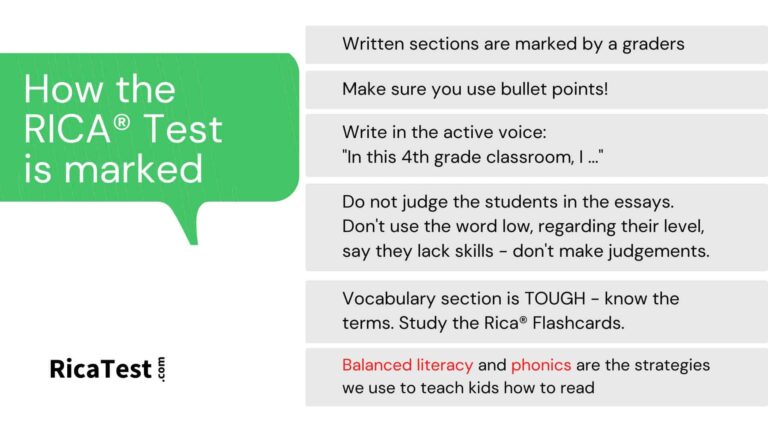
The 4 Most Important Questions To Know
Remember, the Rica Test includes a total of 15 competencies. Within each of these competencies include Rica content specifications, which are topics about providing effective reading instruction to students at the elementary and middle school grade levels.
As the test taker, you will need to know the answers to these four questions about every competency:
- What is it?
- How do you teach it?
- How do you assess it?
- How do you differentiate a lesson to meet the needs of all learners?
- Struggling Readers
- English Learners
- Advanced Learners
More about the above questions:
The RICA Test covers a total of 13 fundamental reading instruction topics, which are listed below. It is absolutely crucial that you know the answers to the four questions listed above for each of the 13 topics below.
The end of every subtest study guide includes a list of student needs that are paired with the
- appropriate definition (what it is)
- instructional strategy (how to teach it)
- assessment method (how to assess it)
- approach to differentiate the lesson (how to meet the needs of all learners)

